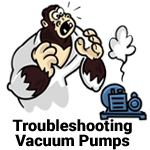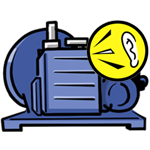
Check Vacuum Pressure. Higher pressure increases noise emitting from pump. If pump vacuum pressure is below 1 Torr, Locate noise source on your vacuum pump (motor, belt, pump).
1- If motor makes noise:
a) Check for loose bolts on motor mount. Tighten bolts, if loose. If the motor is secured to base, the motor bearings may be worn and the motor may need to be replaced.
b) Compare the pump motor rating, printed on a label on the side of the motor and on the serial number tag, to the power source, to be sure they agree in voltage, phase, and frequency.
2- If belt makes noise:
a) The belt tension should be sufficient to drive the pump without visible slippage. Any greater tension will cause noise and possible damage to the bearings of both the motor and pump. Make certain that both pulley grooves are clean and free from oil. The pulleys must be fastened securely on their respective shafts, and in parallel alignment. Use a straight edge to inspect belt alignment.
b) Pulley may be bent. If so, replace.
c) Loose belt, tighten by loosening bolts on motor and moving motor away from pump until belt exhibits a 1/2 inch deflection.
3- If pump makes noise:
a) Vanes may be sticking, carry out a forced oil flush.
b) Check vacuum is below 1 Torr in pressure. Higher pressures create loud gurgling noise and louder operating noises. Two stage oil sealed vacuum pumps must operate below 1 Torr, or will suffer premature wear, excessive loss of oil and pump failure. If pump is operating above 1 Torr, see Insufficient Vacuum section of this guide.
c) Slapping noise is typical for some pumps operating certain processes, if pump is achieving good ultimate pressure and may not indicate pump damage.
4- If noise level is still unsatisfactory: Contact Us for the correct parts and service support.



